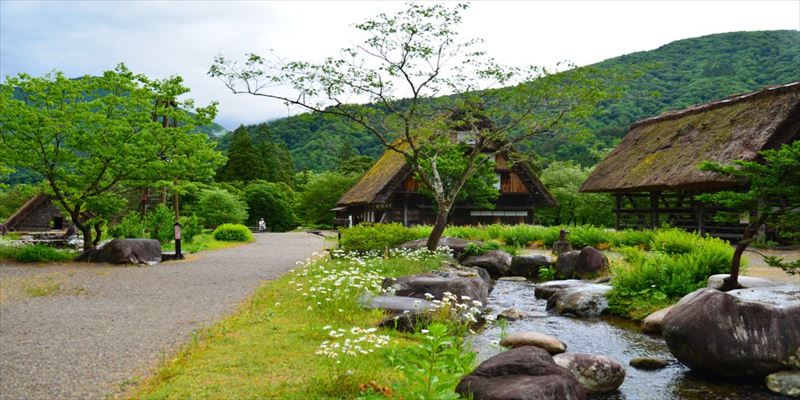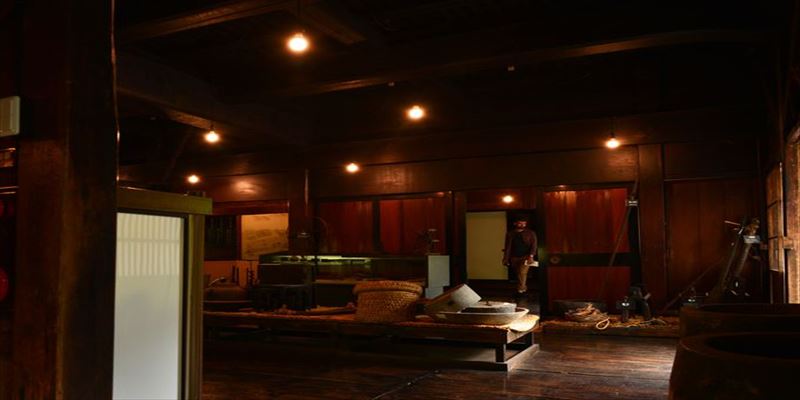The iconic scenery of Shirakawa-go, with its unique thatched-roof farmhouses, is a sight every traveler to Japan should see at least once. Since its registration as a World Cultural Heritage site, this beautiful village has welcomed visitors from all over the globe.
While the main village is stunning, it can also get very crowded. If you’re looking for a place to experience the traditional atmosphere at a more relaxed pace, I highly recommend the “Gassho-zukuri Minkaen,” an open-air museum where you can leisurely stroll among these architectural wonders.
The site features 25 Gassho-zukuri houses, including nine designated as Prefectural Important Cultural Properties, all set amidst a landscape of seasonal wildflowers.
Contents
Shirakawa-go: A Crowded but Unmissable World Heritage Site

Shirakawa-go is located in a heavy snowfall region in the northwestern part of Gifu Prefecture. To prevent snow from accumulating, the village developed its unique “gassho-zukuri” (praying hands style) houses with steep, thatched roofs.
Its nostalgic scenery has long been popular, but its fame has grown since becoming a World Heritage Site. To protect the environment and traditional landscape, private cars are not allowed to enter the main Ogimachi village. But don’t worry; there is a large public parking lot at Seseragi Park. From there, it’s just a short walk across the “Deai Bridge” to reach the main village.
The Minkaen: A Peaceful Alternative to the Main Village

If you have plenty of time, exploring the main Ogimachi village is wonderful. However, some visitors may wish to immerse themselves in the old-fashioned atmosphere in a quieter setting. For those people, I highly recommend the Gassho-zukuri Minkaen Outdoor Museum.
 This open-air museum has relocated and preserved about 25 Gassho-zukuri houses for the public to see.
This open-air museum has relocated and preserved about 25 Gassho-zukuri houses for the public to see.
Among them, nine are designated as Important Cultural Properties of Gifu Prefecture.
And you don’t just see them from the outside. You can actually step inside many of these historic buildings.
Step Back in Time: Inside a Gassho-zukuri Farmhouse

This is the interior of the Nakano family home, located near the entrance of the park.
The central *iori* hearth was not only used for cooking but also provided light and heating. The smoke from the fire also helped to preserve the thatched roof from the inside by repelling insects.
Seating positions around the hearth were also traditionally determined by social status.
To preserve the authentic atmosphere, the lighting is kept dim, allowing you to imagine how people lived in those days.
 Moreover, this museum isn’t just about the ground floor.
Moreover, this museum isn’t just about the ground floor.
In this house, you can climb up to the attic floors where sericulture (silkworm farming) took place.
On your way up, you’ll see old photographs and tools used for raising silkworms, giving you a real sense of their way of life.
Experience a Traditional “Satoyama” Village Landscape

The museum is more than just a collection of houses. It recreates an entire village, complete with a temple, water mill, and small huts. The landscape, with a stream flowing through it, creates a tranquil *satoyama* atmosphere—the traditional Japanese ideal of living in harmony with nature in the mountains.
 In addition to the sericulture exhibits, you’ll find displays of tools for farming and forestry, showing how people lived and worked in this region.
In addition to the sericulture exhibits, you’ll find displays of tools for farming and forestry, showing how people lived and worked in this region.
In some houses, you can watch artisans making daily necessities from straw. It’s a wonderful glimpse into the resourcefulness of traditional Japanese life.
Quirky Details and Charming Discoveries

Each house has its own unique features. Some have two hearths side-by-side, so you can enjoy spotting the differences.
And this detail… the hole in the wall? That’s a doorway made just for the cat!
In this cold climate, the warmth from the hearth was precious, and this little feature shows a charming consideration for the family’s feline members.
You can also eat zenzai (sweet red bean soup) with rice cakes and handmade soba noodles at a restaurant inside the park.
The special ice cream comes in three flavors: vanilla, millet, and buckwheat.
The people of Shirakawa-go have long lived in harmony with nature. Please visit the “Gassho-zukuri Minkaen” Outdoor Museum to feel the culture that has been passed down through generations.
Address: 2499 Ogimachi, Shirakawa Village, Gifu Prefecture, Japan
Phone number: 05769-6-1231
Gassho-zukuri Minkaen Official Website










![11 Maid Cafe Ranking in Tokyo [Recommended even to beginners and ladies!]](https://jatrabridge.com/wp-content/uploads/slider/cache/11597c33ae53b47eb36a2f67968e635f/Maid-Cafe-Ranking-in-Tokyo2.3.jpg)






















